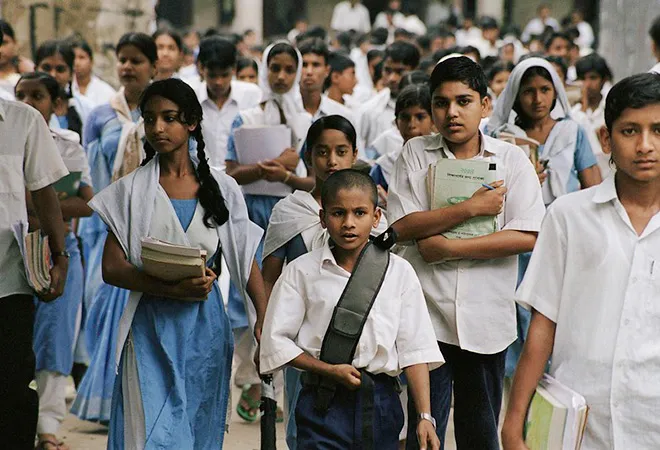 This article is part of the series — India–Bangladesh Relations @50: Commemorating Bilateral Ties.
This article is part of the series — India–Bangladesh Relations @50: Commemorating Bilateral Ties.
The year 2021 marks half a century of the birth of Bangladesh. It was the birth of a nation from the womb of deep intrinsic values: A deep desire for freedom and justice; an appreciation of one’s own mother tongue, culture, and identity; and grit and determination to build on hard work and perseverance. Bangladesh’s growth in the last 50 years has been a testament to her holding forth these values. Today, we witness a populous nation well on its way to prosperity. Throughout, India-Bangladesh relations have been nurtured through a shared destiny due to common geography and shared values based on the sacrifice of martyrs on both sides who fought to uphold those values. The umbilical cord of friendship and trust between India and Bangladesh is soon maturing to become a major conduit for delivering overall growth and regional stability in the immediate and extended neighborhood of both nations. Cooperation between the two governments has unleashed a major force for ensuring physical and digital connectivity.
Recently, while inaugurating the “
Matri Setu” over the Feni river in Tripura, Indian Prime Minister Narendra Modi reiterated the vision and progress in ensuring “HIRA” connectivity — a mesh of highways, information ways, railways, and airways between the neighbours. Adding to this, there has been major progress on inland water connectivity. The narrative of how the untapped trade potential between the two friends can also be uncovered based on this connectivity is gaining pitch. If we were to look at the overall picture in terms of spaces of engagement, the “first space” of government and the political leadership has laid the foundations for taking forward progress and growth that would be driven by the “second space” of industry. A “third space” of ground-level stakeholders now also needs to be nurtured: Bonds of hearts and minds ning the political and national borders, based on ground up ideas to reap the benefits of connectivity.
Cooperation between the two governments has unleashed a major force for ensuring physical and digital connectivity.
A few factors that need to be given careful consideration in this regard: Firstly, with the passage of time and the passing of the generations that witnessed the birth of Bangladesh, steps must be made to reinforce more interest of the younger generations in India and Bangladesh in each other. Regular exchanges between younger entrepreneurs and civil society based on areas such as culture, music, sports, films, and sharing of best practices in sustainable development, human capital development, gender equitable growth, amongst others, needs to be pursued. Leveraging on technology and social media, such exchanges can be a combination of online and physical meetings.
Secondly, steps must be taken to keep the horrific memory of the war genocide alive and celebrate the martyrs who laid down their lives for the cause of freedom, lest the world and we forget. Setting up of a genocide museum in Bangladesh would forever mark the scale of the tragedy and the sacrifice of millions in the fight to liberate Bangladesh.
Thirdly, steps can be taken to facilitate more exchanges of people at the shared borders, and between communities who live at the borders as well as the border and the mainstream. Increasing tourist footfall at select border locations such as at Akhaura in Tripura and Dawki in Meghalaya from both sides and facilitating a mechanism of exchange through the creation of a common entertainment zone at the border with a curated calendar of events can go a long way to spur interest in the “other” side.
Setting up of a genocide museum in Bangladesh would forever mark the scale of the tragedy and the sacrifice of millions in the fight to liberate Bangladesh.
Fourthly, the rich cultural and natural heritage of Bangladesh holds enormous tourism potential. The beaches of Cox bazaar, swamp of Ratergul, the tea gardens of Sylhet, the heritage of Rabindranath Tagore, the Shaktipeetah temples, and the Buddhist sites in Chittagong can be popular destinations for Indian and international tourists. Offering combinations circuits with Northeast India can be a game changer in attracting mainstream Indian tourists to Bangladesh and complementing the interest in the younger generation in Bangladesh to visit India.
Lastly, for all these to happen, there is a need to jointly work towards a new paradigm of security at the shared borders. A paradigm that enables borders to be not merely thick lines which demarcate national boundaries but act as “connector zones” for inclusive growth and prosperity; all this while addressing ongoing concerns on both sides — issues such as illegal migration, trafficking, etc.
As we step in to celebrate 50 years of Bangladesh in 2021 and India turns 75 in 2022, it would be opportune to reflect on how to empower the “third space” between the two nations: The space which breathes on mutual trust and love that can provide the ecosystem for nurturing growth and stability for the next half a century.
The views expressed above belong to the author(s). ORF research and analyses now available on Telegram! Click here to access our curated content — blogs, longforms and interviews.



 This article is part of the series —
This article is part of the series —  PREV
PREV


